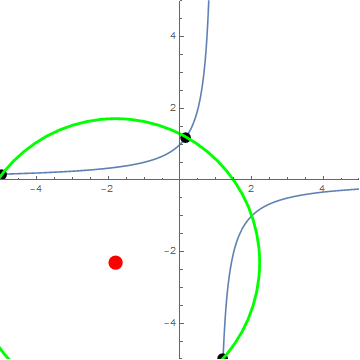Circles generated by three-fold iterations $f(x)=\frac{1}{1-x}$
The equation of a circle through $A$, $B$, $C$ is given by: $$\left|\begin{array}{cccc} x^2+y^2 & x & y & 1 \\ A_x^2+A_y^2 & A_x & A_y & 1 \\ B_x^2+B_y^2 & B_x & B_y & 1 \\ C_x^2+C_y^2 & C_x & C_y & 1 \end{array}\right| = 0 \tag{1}$$ For $$A = \left(p,\frac{1}{1-p}\right)\qquad B = \left(\frac{1}{1-p},\frac{p-1}{p}\right) \qquad C = \left(\frac{p-1}{p},p\right)$$ this becomes (with the help of a computer algebra system) $$\left(x^2+y^2\right)p(p-1) - x\left(1- 3 p + p^3\right) -y\left(1 - 2 p - p^2 + p^3\right) = -1 - p + 4 p^2 - p^3 \tag{2}$$ Completing the square yields $$\left(x -\frac{p^3-3p+1}{2p(p-1)} \right)^2+\left(y - \frac{p^3-p^2-2p+1}{2p(p-1)} \right)^2 = \frac{\left(p^2 + 1\right) \left(p^2-2p+2\right) \left(2p^2-2p+1\right)}{4 p^2(p-1)^2} \tag{$\star$}$$
Thus, the circumcenter $K$ and radius $r$ are
$$\begin{align} K &= \left(\frac{p^3-3p+1}{2p(p-1)}, \frac{p^3-p^2-2p+1}{2p(p-1)}\right)\\[6pt] r &= \frac{\sqrt{\left(p^2+1\right) \left(\,(p-1)^2+1\,\right) \left(\,p^2+(p-1)^2\,\right)\;}}{2 |p(p-1)|} \end{align}$$
Interestingly, we can rewrite $r$ as $$r = \frac12 \;\sqrt{\left(\frac{p}{1} + \frac{1}{p}\right) \left(\frac{p - 1}{1} + \frac{1}{p - 1}\right) \left(\frac{p}{p - 1} + \frac{p - 1}{p}\right)}$$
Animation courtesy of @Jyrki:

By way of minimization ... We have $$\frac{d(r^2)}{dp} = \frac{(p-2) (p+1) (2p-1) (p^2-p+1)^2}{2 p^3(p-1)^3}$$ so that the non-extraneous critical points occur at $p=2,-1,\frac12$, which correspond exactly to OP's $\langle 2\rangle$ triangle, as can be seen in the animation.
Given a point $x\in\Bbb{R}$, with $x\notin\{0,1\}$, the corresponding three points are $$P_1(x)=\left(x,\tfrac{1}{1-x}\right), \qquad P_2(x)=\left(\tfrac{1}{1-x},\tfrac{x-1}{x}\right), \qquad P_3(x)=\left(\tfrac{x-1}{x},x\right).$$ Then we want to find the unique circle passing through these three points. Note that these three points are not collinear for any choice of $x\in\Bbb{R}$ with $x\notin\{0,1\}$, so such a circle does indeed exist. Now we want to find $a,b,r\in\Bbb{R}$ such that $$||P_i(x)-(a,b)||^2=r^2,$$ for $i\in\{1,2,3\}$. This yields the following three equations: \begin{eqnarray*} \left(x-a\right)^2+\left(\tfrac{1}{1-x}-b\right)^2&=&r^2,\\ \left(\tfrac{1}{1-x}-a\right)^2+\left(\tfrac{x-1}{x}-b\right)^2&=&r^2,\\ \left(\tfrac{x-1}{x}-a\right)^2+\left(x-b\right)^2&=&r^2. \end{eqnarray*} Clearing all denominators then yields the following system of equations: \begin{eqnarray*} (1-x)^2(x-a)^2+(1-(1-x)b)^2&=&(1-x)^2r^2,\\ x^2(1-(1-x)a)^2+(1-x)^2((x-1)-xb)^2&=&x^2(1-x)^2r^2,\\ ((x-1)-xa)^2+x^2(x-b)^2&=&x^2r^2. \end{eqnarray*} We can rearrange these to make them look more like polynomials in $a$, $b$ and $r$: \begin{eqnarray*} (1-x)^2&a^2-2x(1-x)^2&a+(1-x)^2&b^2-2(1-x)&b+x^2(1-x)^2+1&=(1-x)^2&r^2,\\ x^2(1-x)^2&a^2-2x^2(1-x)&a+x^2(1-x)^2&b^2+2x(1-x)^3&b+(1-x)^4+x^2&=x^2(1-x)^2&r^2,\\ x^2&a^2+2x(1-x)&a+x^2&b^2-2x^3&b+x^4+(1-x)^2&=x^2&r^2. \end{eqnarray*} Multiplying the first equation by $x^2$ and subtracting it from the second shows that $$-2x^2(1-x)(x^2-x+1)a+2x(1-x)(x^2-x+1)b-(x-1)^2(x^4-x^2+2x-1)=0.$$ Note that this equation is linear in both $a$ and $b$. In the same way we can multiply the third equation by $(1-x)^2$ and subtract it from the second to find that $$-2x(1-x)(x^2-x+1)a-2x(1-x)^2(x^2-x+1)b-x^2(x^4-2x^3+x^2-1)=0,$$ which is again linear in $a$ and $b$. Now we have a system of two linear equations in two variables, which we can solve by linear algebra. Dividing by $x\neq0$ and $1-x\neq0$ yields the system: \begin{eqnarray*} -2x^2(x^2-x+1)&a&+2x(x^2-x+1)&b&=(x-1)(x^4-x^2+2x-1),\\ -2(1-x)(x^2-x+1)&a&-2(1-x)^2(x^2-x+1)&b&=x(x^4-2x^3+x^2-1). \end{eqnarray*} Because also $x^2-x+1\neq0$ for all real numbers $x$, we can also write this as \begin{eqnarray*} -x&a&+&b&=\frac{x-1}{x}\frac{x^4-x^2+2x-1}{2(x^2-x+1)},\\ -&a&-(1-x)&b&=\frac{x}{1-x}\frac{x^4-2x^3+x^2-1}{2(x^2-x+1)}. \end{eqnarray*} It follows that \begin{eqnarray*} a&=&\frac{x^5-x^4-2x^3+4x^2-4x+1}{2x(x-1)(x^2-x+1)}=\frac{x^3-3x+1}{2x(x-1)},\\ b&=&\frac{x^5-2x^4+2x^2-3x-1}{2x(x-1)(x^2-x+1)}=\frac{x^3-x^2-2x+1}{2x(x-1)}, \end{eqnarray*} and plugging this back into the original equations shows that $$r^2=\frac{2x^6-6x^5+11x^4-12x^3+11x^2-6x+2}{4x^2(x-1)^2} =\frac{(x^2+1)(x^2-2x+2)(2x^2-2x+1)}{(2x(x-1))^2}.$$ It is interesting to note that the square of the radius can also be expressed as \begin{eqnarray*} r(x)^2&=&\frac14\left|f^{0}(x)+\frac{1}{f^{0}(x)}\right| \left|f^{1}(x)+\frac{1}{f^{1}(x)}\right| \left|f^{2}(x)+\frac{1}{f^{2}(x)}\right|,\\ &=&\frac{1}{4|f^{0}(x)f^{1}(x)f^{2}(x)|} \left(f^0(x)^2+1\right) \left(f^1(x)^2+1\right) \left(f^2(x)^2+1\right)\\ &=&\frac14\prod_{i=0}^2||(f^i(x),1)||^2, \end{eqnarray*} and hence we see that $$r(x)=\frac12\prod_{i=0}^2\left|\left|(f^i(x),1)\right|\right|.$$